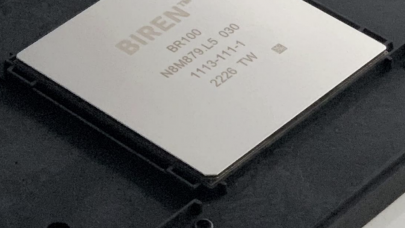
Chip Pioneers to Battle it out in Modern RISC-V AI Chips
August 25, 2022
Some chip pioneers from the 1980s are raising the ante in modern chip design with new opportunities provided by artificial intelligence and the open-source RISC-V architecture. Untether AI, which was co-founded by an analog and mixed signal chip pioneer Martin Snelgrove, released a new AI inferencing chip called Boqueria, which has more than 1,400 optimized RISC-V processors. That chip will compete... Read more…

Groq Designs Chip that Hands Over Controls to Software
August 25, 2022
Groq has deconstructed the conventional CPU, and designed its chip in which software takes over control of the chip. The Groq Tensor Streaming Processor Architecture follows a growing trend of software controlling system functions, which has happened in autonomous cars, networking and other hardware. The architecture hands over hardware controls of the chip to the compiler. The chip has integrated... Read more…

AMD Previews 400 Gig Adaptive SmartNIC SOC at Hot Chips
August 24, 2022
Fresh from finalizing its acquisitions of FPGA provider Xilinx (Feb. 2022) and DPU provider Pensando (May 2022) ), AMD previewed what it calls a 400 Gig Adaptive smartNIC SOC yesterday at Hot Chips. It is another contender in the increasingly crowded and blurry smartNIC/DPU space where distinguishing between the two isn’t always easy. The motivation for these device types... Read more…

Chinese Startup Biren Details BR100 GPU
August 22, 2022
Amid the high-performance GPU turf tussle between AMD and Nvidia (and soon, Intel), a new, China-based player is emerging: Biren Technology, founded in 2019 and headquartered in Shanghai. At Hot Chips 34, Biren co-founder and president Lingjie Xu and Biren CTO Mike Hong took the (virtual) stage to detail the company’s inaugural product: the Biren BR100 general-purpose GPU (GPGPU). “It is my honor to present... Read more…

Tesla Bulks Up Its GPU-Powered AI Super – Is Dojo Next?
August 16, 2022
Tesla has revealed that its biggest in-house AI supercomputer – which we wrote about last year – now has a total of 7,360 A100 GPUs, a nearly 28 percent uplift from its previous total of 5,760 GPUs. That’s enough GPU oomph for a top seven spot on the Top500, although the tech company best known for its electric vehicles has not publicly benchmarked the system. If it had, it would... Read more…

Anton 3 Is a ‘Fire-Breathing’ Molecular Simulation Beast
September 1, 2021
Life sciences computational research has long been dominated by statistics and parallel processing more than traditional HPC. Think gene sequencing and variant calling. Mechanistic simulation and modeling has played a much smaller role though that’s changing. An exception is the Anton line of... Read more…

Esperanto, Silicon in Hand, Champions the Efficiency of Its 1,092-Core RISC-V Chip
August 27, 2021
Esperanto Technologies made waves last December when it announced ET-SoC-1, a new RISC-V-based chip aimed at machine learning that packed nearly 1,100 cores onto a package small enough to fit six times over on a single PCIe card. Now, Esperanto is back, silicon in-hand and taking aim... Read more…

Hot Chips: Here Come the DPUs and IPUs from Arm, Nvidia and Intel
August 25, 2021
The emergence of data processing units (DPU) and infrastructure processing units (IPU) as potentially important pieces in cloud and datacenter architectures was Read more…

- Click Here for More Headlines

Whitepaper
Transforming Industrial and Automotive Manufacturing
In this era, expansion in digital infrastructure capacity is inevitable. Parallel to this, climate change consciousness is also rising, making sustainability a mandatory part of the organization’s functioning. As computing workloads such as AI and HPC continue to surge, so does the energy consumption, posing environmental woes. IT departments within organizations have a crucial role in combating this challenge. They can significantly drive sustainable practices by influencing newer technologies and process adoption that aid in mitigating the effects of climate change.
While buying more sustainable IT solutions is an option, partnering with IT solutions providers, such and Lenovo and Intel, who are committed to sustainability and aiding customers in executing sustainability strategies is likely to be more impactful.
Learn how Lenovo and Intel, through their partnership, are strongly positioned to address this need with their innovations driving energy efficiency and environmental stewardship.
Download Now
Sponsored by Lenovo
Whitepaper
How Direct Liquid Cooling Improves Data Center Energy Efficiency
Data centers are experiencing increasing power consumption, space constraints and cooling demands due to the unprecedented computing power required by today’s chips and servers. HVAC cooling systems consume approximately 40% of a data center’s electricity. These systems traditionally use air conditioning, air handling and fans to cool the data center facility and IT equipment, ultimately resulting in high energy consumption and high carbon emissions. Data centers are moving to direct liquid cooled (DLC) systems to improve cooling efficiency thus lowering their PUE, operating expenses (OPEX) and carbon footprint.
This paper describes how CoolIT Systems (CoolIT) meets the need for improved energy efficiency in data centers and includes case studies that show how CoolIT’s DLC solutions improve energy efficiency, increase rack density, lower OPEX, and enable sustainability programs. CoolIT is the global market and innovation leader in scalable DLC solutions for the world’s most demanding computing environments. CoolIT’s end-to-end solutions meet the rising demand in cooling and the rising demand for energy efficiency.
Download Now
Sponsored by CoolIT
Advanced Scale Career Development & Workforce Enhancement Center
Featured Advanced Scale Jobs:
HPCwire Resource Library
HPCwire Product Showcase
© 2024 HPCwire. All Rights Reserved. A Tabor Communications Publication
HPCwire is a registered trademark of Tabor Communications, Inc. Use of this site is governed by our Terms of Use and Privacy Policy.
Reproduction in whole or in part in any form or medium without express written permission of Tabor Communications, Inc. is prohibited.
























